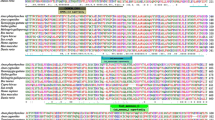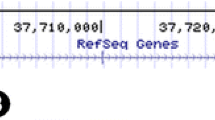Abstract
Dopamine D1 receptor (DRD1) is one of the dopamine receptors with seven transmembrane domains that are coupled to the G protein. In the present study, we cloned the full coding region of DRD1 gene by the reverse transcription polymerase chain reaction (RT-PCR) and rapid amplification of cDNA ends from the goose hypothalamus tissues. Results showed that the goose DRD1 cDNA (GenBank: KF156790) contained a 1,356 bp open reading frame encoding a protein 452 amino acid with a molecular weight of 50.52 kDa and a isoelectric point of 6.96. Bioinformatics analysis indicated that the deduced amino acid sequence was 71–98 % identical to the DRD1 protein of other species, contained seven transmembrane domains and four N-glycosylation sites. A phylogenetic tree analysis revealed that the deduced goose DRD1 protein had a close genetic relationship and evolutional distance with that of duck, chicken, and zebra finch. The semi-quantitative RT-PCR analysis displayed goose DRD1 gene was widely expressed in all detected tissues, including heart, lung, liver, spleen, kidney, breast muscle, duodenum, sebum, pituitary, hypothalamus, ovary and oviduct. Eighteen single nucleotide polymorphisms were indentified in 3,169 bp length of this gene. For G90A mutation, the genotyping analysis of PCR-TspRI–RFLP showed the allele G was in dominance in all detected goose breeds, and the allele frequencies of this polymorphism were significantly different between Chinese goose breeds and foreign breeds (P < 0.01). These findings will help us understand the functions of the DRD1 gene and the molecular breeding in geese.






Similar content being viewed by others
References
Youngren OM, el Halawani ME, Silsby JL, Phillips RE (1991) Intracranial prolactin perfusion induces incubation behavior in turkey hens. Biol Reprod 44:425–431
March JB, Sharp PJ, Wilson PW, Sang HM (1994) Effect of active immunization against recombinant-derived chicken prolactin fusion protein on the onset of broodiness and photoinduced egg laying in bantam hens. J Reprod Fertil 101:227–233
Reymond MJ, Porter JC (1985) Involvement of hypothalamic dopamine in the regulation of prolactin secretion. Horm Res 22:142–152
Xu M, Proudman JA, Pitts GR, Wong EA, Foster DN, El Halawani ME (1996) Vasoactive intestinal peptide stimulates prolactin mRNA expression in turkey pituitary cells: effects of dopaminergic drugs. Proc Soc Exp Biol Med 212:52–62
Ben-Jonathan N, Hnasko R (2001) Dopamine as a prolactin (PRL) inhibitor. Endocr Rev 22:724–763
Blasi G, Bianco LL, Taurisano P, Gelao B, Romano R, Fazio L, Papazacharias A, Giorgio AD, Caforio G, Rampino A, Masellis R, Papp A, Ursini R, Sinibaldi L, Popolizio T, Sadee W, Bertolino A (2009) Functional variation of the dopamine D2 receptor gene is associated with emotional control as well as brain activity and connectivity during emotion processing in humans. J Neurosci 29:14812–14819
Baskerville TA, Douglas AJ (2010) Dopamine and oxytocin interactions underlying behaviors: potential contributions to behavioral disorders. CNS Neurosci Ther 16:92–123
Korchounov A, Meyer MF, Krasnianski M (2010) Postsynaptic nigrostriatal dopamine receptors and their role in movement regulation. J Neural Transm 117:1359–1369
Laitinen JT (1993) Dopamine stimulates K+efflux in the chick retina via D1 receptors independently of adenylyl cyclase activation. J Neurochem 61:1461–1469
Schnell SA, You S, El Halawani ME (1999) D1 and D2 dopamine receptor messenger ribonucleic acid in brain and pituitary during the reproductive cycle of the turkey hen. Biol Reprod 60:1378–1383
Chaiseha Y, Youngren O, Al-Zailaie K, Halawani El (2003) Expression of D1 and D2 dopamine receptors in the hypothalamus and pituitary during the turkey reproductive cycle: colocalization with vasoactive intestinal peptide. Neuroendocrinology 77:105–118
Xu HP, Shen X, Zhou M, Fang MX, Zeng H, Nie QH, Zhang XQ (2010) The genetic effects of the dopamine D1 receptor gene on chicken egg production and broodiness traits. BMC Genet 11:17
Wang C, Li S, Li C, Feng Y, Peng X, Gong Y (2012) Molecular cloning, expression profile, polymorphism and the genetic effects of the dopamine D1 receptor gene on duck reproductive traits. Mol Biol Rep 39:9239–9246
Joseph S, David WR (2002) In: Huang PT (ed) Molecular cloning a laboratory manual, 3rd edn. Science, Beijing
Edgar RC (2004) MUSCLE: multiple sequence alignment with high accuracy and high throughput. Nucleic Acids Res 32:1792–1797
Tamura K, Peterson D, Peterson N, Stecher G, Nei M, Kumar S (2011) MEGA5: molecular evolutionary genetics analysis using maximum likelihood, evolutionary distance, and maximum parsimony methods. Mol Biol Evol 28:2731–2739
Xu H, Gregory SG, Hauser ER, Stenger JE, Pericak-Vance MA, Vance JM, Züchner S, Hauser MA (2005) SNP selector: a web tool for selecting SNPs for genetic association studies. Bioinformatics 21:4181–4186
Acknowledgments
The authors thank Prof. Yanzhang Gong for the kind advice on this research (Huazhong Agricultural University). This study was supported by the Fund of China Agriculture Research System (Grant No. CARS-43), the Key Research Program of Prospering Agriculture Through Science and Technology of Shanghai Management Office (Grant No. 2009: 2-1) and the Construction Program of Zhedong White Goose Breeding Platform.
Author information
Authors and Affiliations
Corresponding author
Rights and permissions
About this article
Cite this article
Wang, C., Liu, Y., Wang, H. et al. Molecular characterization, expression profile, and polymorphism of goose dopamine D1 receptor gene. Mol Biol Rep 41, 2929–2936 (2014). https://doi.org/10.1007/s11033-014-3149-y
Received:
Accepted:
Published:
Issue Date:
DOI: https://doi.org/10.1007/s11033-014-3149-y




